Contents
Host diseases can be fungal or viral in origin. Some ailments are very dangerous and cannot be cured, others can be quickly eliminated, but in any case, it is necessary to distinguish between their symptoms.
Causes and signs of damage to the host by diseases
Most often, the host is affected by fungal diseases. The main reason is improper care of the plant. The development of fungi is especially promoted by:
- swampy and acidic soil;
- lack of mineral elements in the soil;
- excessive shading or excess sunlight;
- dense plantings, if the flower bed on which the host grows is too dense, the risk of disease increases;
- poor sanitary condition of the site and uncollected plant debris;
- poor ventilation and rare loosening of the soil.
In addition to fungi, ornamental culture can be affected by viruses. Such diseases are most often carried by insect pests. In addition, the virus can penetrate the tissues of the host from the soil, for example, if a diseased plant grew on the site earlier, and the site after it was not disinfected. In some cases, seedlings turn out to be sick already during planting; not all nurseries are able to guarantee the unconditional quality of the material.
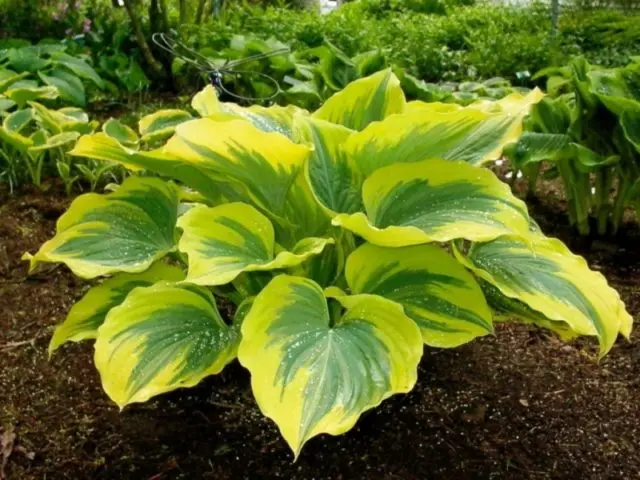
Hosta can suffer from diseases and pests due to improper care.
Symptoms of viral and fungal diseases are usually very similar. The gardener should be wary if:
- at the hosta, the leaves begin to turn yellow, weaken and curl;
- the plant stops growing, loses its hue saturation and does not bloom;
- leaf plates are covered with an ugly bloom or spots of light and dark color.
At the first symptoms, the decorative culture should be studied more carefully. This will determine what exactly she is sick with, and immediately begin treatment.
Hosta diseases with photos and their treatment
Garden hosta can suffer from diseases of viral and fungal origin. To take the right control measures, you need to study the photo and description of diseases and learn how to distinguish them from each other.
Rust
Rust is a fairly common disease of decorative culture. It occurs most often in hot summers with insufficient watering. The disease is easily recognizable by reddish-brown spots that quickly cover the leaf plates and merge with each other. Under the influence of rust, the leaves begin to dry and wither, which can lead to the death of the hosta.
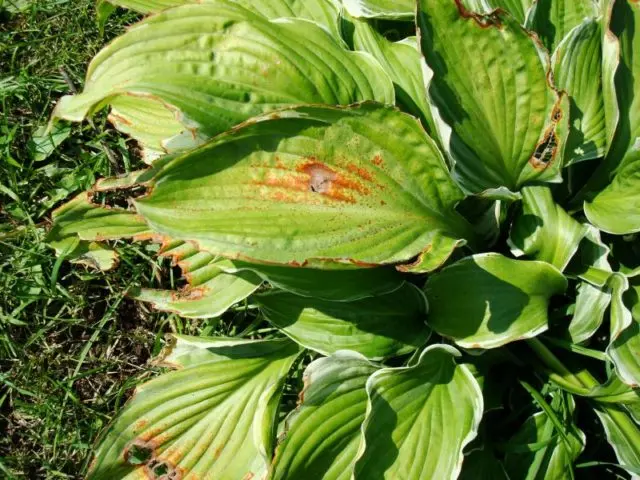
With rust, orange-brown spots appear on the leaves.
Rust control is carried out with the help of fungicidal preparations, for example, Fundazol or Bordeaux mixture. In this case, the leaves affected by the disease must be removed. If the disease has not had time to spread too much, then spraying allows you to cope with it.
crown rot
The disease is characterized by yellowing and wilting of the leaves from the outside to the center, which explains the name. The cause of yellowing is root rot – a diseased hosta ceases to receive nutrition from the soil and rapidly fades. The structure of the leaf plates can become loose, large sheets simply begin to break away from the bush. In advanced cases, white threads of fungal mycelium become noticeable on the host.
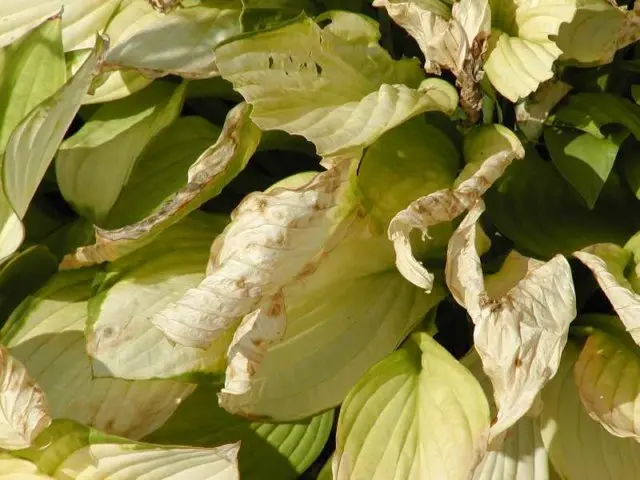
With crown rot, the host begins to turn yellow on the outside of the crown.
Treating crown rot is difficult because the roots can be severely affected by the time symptoms appear. If the symptoms of the disease are mild, you can treat the host and the soil around its roots with fungicidal preparations. In case of severe damage, it is better to dig up and destroy the bush until the fungus has moved to neighboring crops.
Phyllostictosis
Fungal disease leads to the appearance of brown spots on the leaf plates of a garden plant. Gradually, these spots merge with each other and completely cover the leaf, and a yellowish or whitish coating forms on top. Necrotic areas dry up and crumble, the ornamental plant dies.

Phyllosticosis leaves brown spots, which are then covered with plaque
Phyllostictosis usually appears in waterlogged conditions. To combat the disease, you need to treat the host with Abiga-Peak, Strobi or blue vitriol, and also reduce the frequency of watering.
Antraknoz
A common disease affects mainly hosts growing in shady areas and in moist soils. Anthracnose appears as brown spots and dots with a dark border on the leaf plates. Gradually, the spots grow over the entire sheet, due to which it dries out, deforms and falls off.
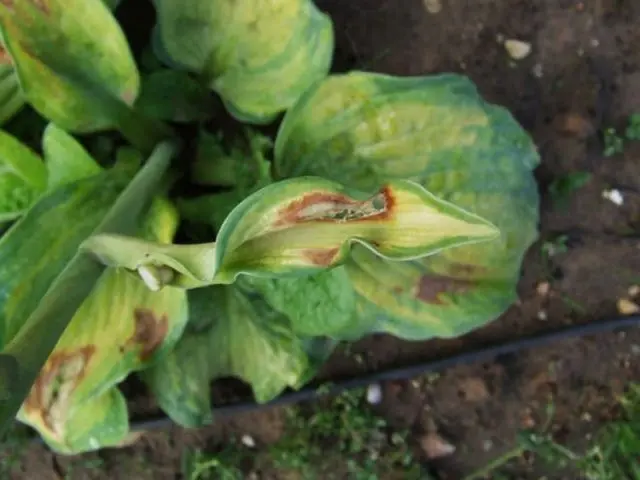
With anthracnose, brown spots appear with a dark border
To treat anthracnose, it is necessary to completely remove the affected leaf plates, and then spray the plantings with fungicidal agents – Fundazol or Bordeaux liquid. The area with the hosts needs to be thinned out to ensure good ventilation. It is better to reduce watering, the appearance of anthracnose indicates that the soil is waterlogged.
soft rot
A dangerous bacterial disease affects the hosta in the lower part and leads to the decomposition of the stem and lower leaves. You can recognize a fungal disease by brown spots on the leaf plates and a characteristic putrid odor emanating from the host.
The disease appears most often in conditions of high humidity, in the presence of damage to the leaves and stems, as well as after freezing of the host during spring frosts. Soft rot cannot be treated; the diseased host will have to be completely removed from the site. After that, the tools must be thoroughly washed and disinfected, and the soil should be treated with formalin just in case.
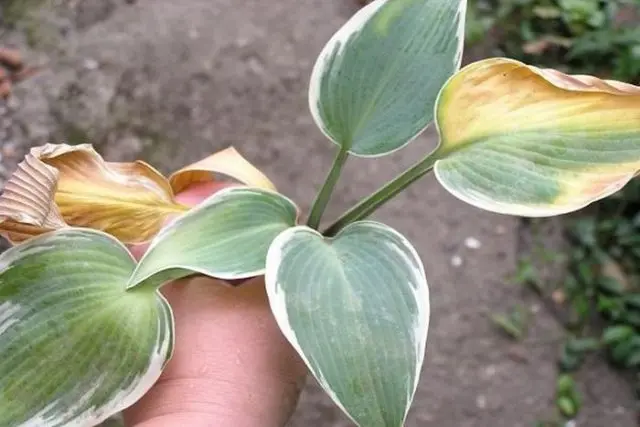
With soft rot, the leaves and stem of the plant simply begin to decompose.
Sclerotinia
Fungal disease begins to spread from the root neck of the bush. At the same time, whitish threads resembling cotton wool fibers form on the surface of the stem in the lower part. The leaves of the hosta become covered with brown spots and begin to die off, black sclerotia gradually appear at the site of the plaque.
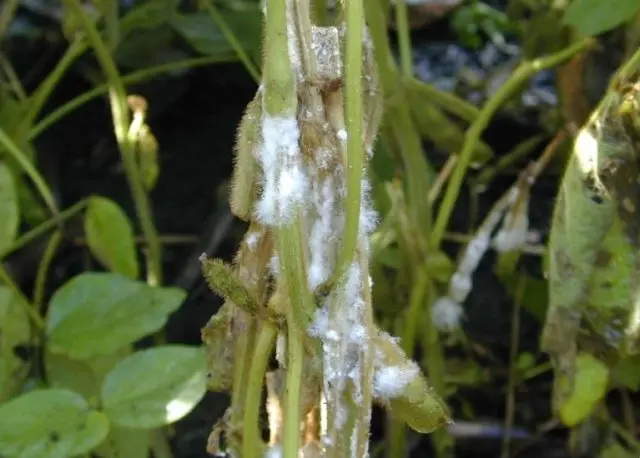
It is easy to recognize sclerotinia by whitish threads on the stem
Sclerotinia is a dangerous disease that cannot be cured. The affected host can only be removed from the site and cultivate the soil in which it grew so that the disease does not affect other plantings.
Gray mold
You can recognize the disease by the appearance of ashy plaque on the leaves. As the disease progresses, the leaves begin to rot and the tops dry. Ultimately, the affected parts of the plant die off, the host stops growing and wilts. Gray rot spreads rapidly and, if left untreated, captures neighboring crops.
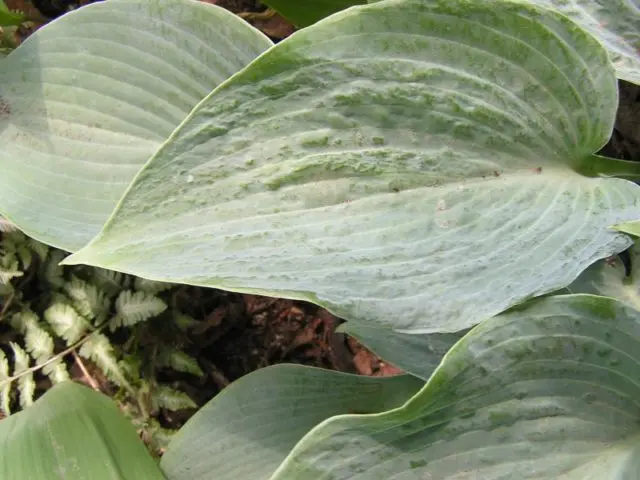
Gray rot leaves a whitish coating on the leaf plates
With a weak lesion, you can treat the host with Fundazol or Ridomil Gold, after cutting off all the affected areas. If the plant is seriously infected, it is best to dig it up and burn it.
tobacco rattle virus
An incurable viral disease poses a serious threat to many crops, vegetables, flowering perennials and hostas. When infected, the culture stops growing, and its shoots and leaves are deformed, necrotic spots and speckled areas appear on the leaf plates. It is impossible to cope with the virus, the plant affected by the disease can only be eliminated.
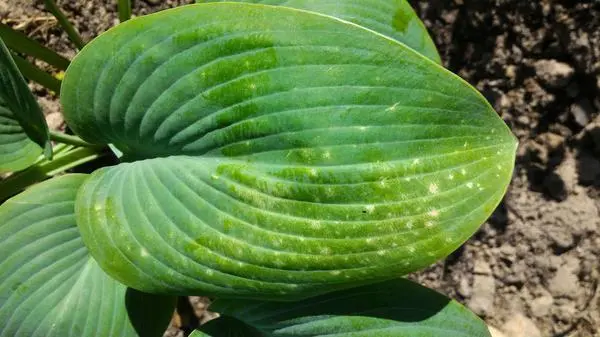
The rattle virus leaves light spots and mosaics on the leaf plates.
The rattle of tobacco is dangerous because it easily passes to other plants through the soil and uncleaned tools. Therefore, after removing the hosta from the soil, it is necessary to thoroughly disinfect both the soil and the pruner or knife with which the plant was cut.
leaf curl virus
Leaf curl is a viral disease that most often affects tomatoes, but the host also suffers from it. The infection disrupts the plant’s growth functions, the leaves shrivel and deform, tear in separate places, and become covered with small star-shaped spots. In the later stages of the disease, necrotic areas appear in place of these spots, which quickly fall out of the leaf tissue.
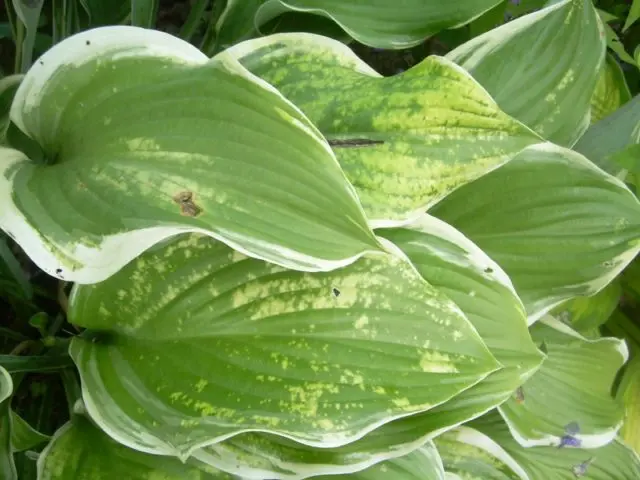
From the curl virus, the leaf plates are deformed and covered with an uneven light pattern.
There is no cure for viral curl, so the host can only be removed from the site. The soil after it should be disinfected and in the future, carefully monitor other plants.
Virus X (HVX)
Hosta virus X, or HVX, is a dangerous disease that is specific to this horticultural crop. She was discovered in 1996, and her symptoms are very similar to those of other viral mosaics. With the defeat of the X virus, the leaves of the plant begin to curl, specks and mosaics appear on them, the plant dies over time.
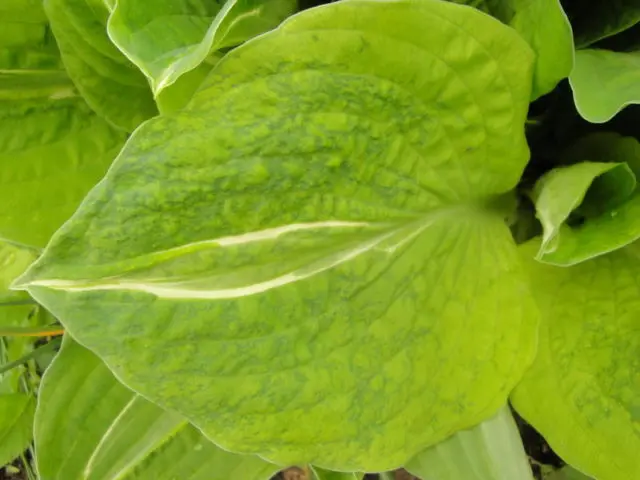
From the host mosaic virus, the host brightens unevenly and begins to curl
At the first symptoms of the virus, the host must be removed from the flower bed and burned, and after that, not only the soil, but also tools, and even work clothes should be disinfected. Virus X is very easily transmitted to other plants along with the remnants of the juice of an infected specimen.
Hosta pests and methods of dealing with them
For hostas in the garden, not only fungi are dangerous, but also harmful insects. Parasites can cause no less damage to a flower bed, but most of them can be successfully dealt with.
leafy nematodes
Small nematode worms can infect both the root system of plants and the aerial part, but on the host they are usually localized precisely in the leaves. You can learn about the presence of worms by the characteristic dark stripes on the stems and leaves, indicating the path of movement of the pest from the roots.
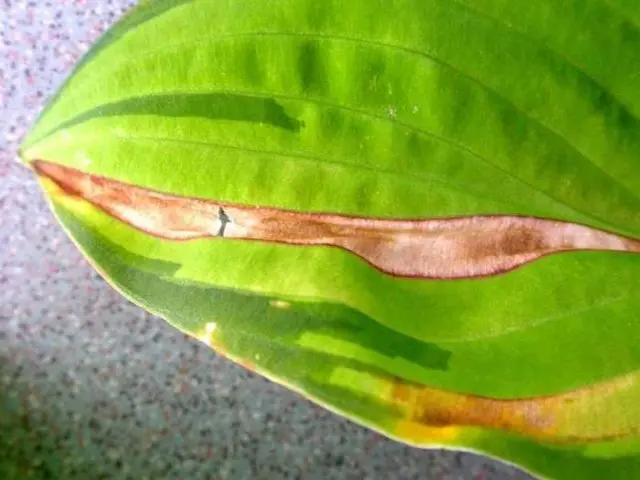
You can find out about the presence of nematodes by the characteristic brown stripes
Nematodes are one of the few pests that have yet to be eradicated. The affected bush is simply burned by the hosts, and then the soil and garden tools are disinfected.
Snails
Large garden hostas often attract the attention of snails. Gastropods capture the leaf plates of the plant and feed on greens and stems. If you do not start the fight on time, then the snails will be able to completely eat the hosta bush to the very root.
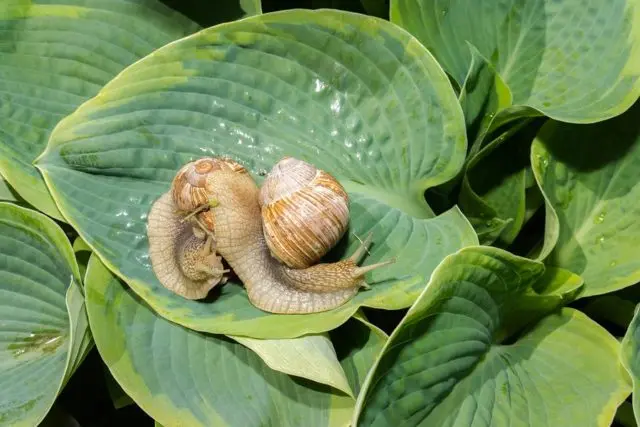
Snails can seriously eat a garden plant
Since snails overwinter in the soil, in the spring it is recommended to loosen the soil at the roots of the hosta and replace its top layer. During the warm season, the leaves of the plant should be regularly inspected. The found snails are removed manually, with a large number of insects, the host can be sprayed with soapy water.
Beetles
Ornamental hosta can suffer from beetles, and in particular from mower weevils, which are a threat to roots and leaves. The larvae of the beetle develop in the soil and eat the roots of the plant, the adult pest feeds on the stems and leaf plates. The beetle looks like a large insect up to 10 cm long with a dark shell.
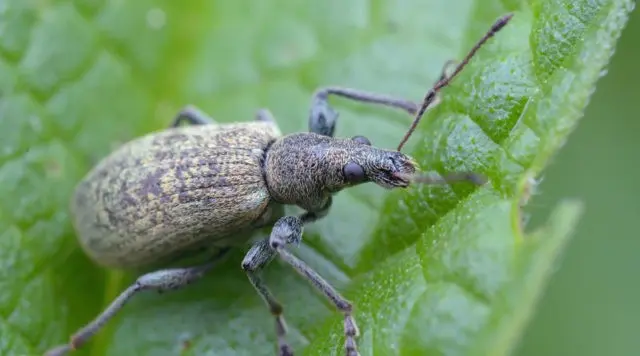
Beetles leave holes on leaf blades.
You can find out about the presence of beetles by the appearance of semicircular holes along the edges of the leaf plates. The pest often affects the host on dry and poor soils. When affected by beetles, the host should be immediately sprayed with an insecticidal solution, for example, Aktellik or Aktara, and the entire flower bed is treated.
Caterpillars
Butterfly caterpillars that feed on hosta juices are no less dangerous for an ornamental plant. Caterpillars are easy to recognize, as a result of their vital activity, through holes appear on the leaves, uneven grooves at the edges. The buds and flowers of the hosta suffer during the flowering period.

Caterpillars actively feed on hosta green mass.
With a small infection, you can collect the caterpillars manually, they are also simply washed off the leaves with a stream of water. If there are a lot of pests, then the host needs to be treated with Karbofos, Intavir and other means.
Rodents
Hosta is a fairly large garden plant. Therefore, it often attracts the attention of rodents – mice, rats and others. Rodents damage the roots and thick stems of the plant, which leads to the death of plantings. You can find out about the appearance of pests by characteristic damage in the lower part of the stem and by impaired growth.
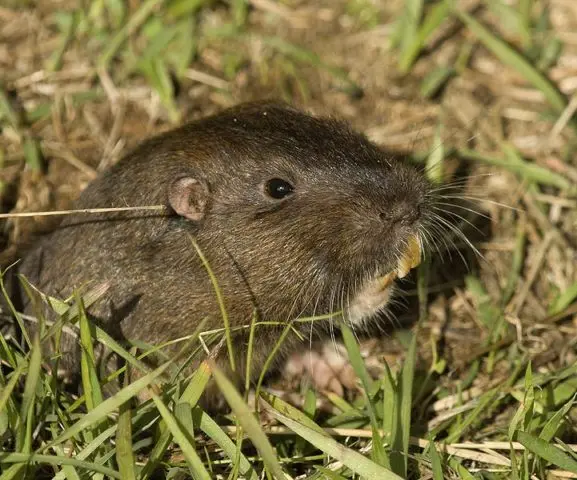
For decorative hosts, not only insects are dangerous, but also rodents.
The fight against rodents is usually carried out with the help of poisonous baits – the granules are scattered under the bushes. For the winter, the cropped plant must be tightly mulched with compost or peat. If there are pets on the site, it is important to ensure that they do not accidentally eat poison intended for rats and mice.
Slugs
Gastropods feed on the green parts of the plant and are especially likely to attack thin-leaved hosts, young specimens and dwarf varieties. You can find out about the presence of slugs by silvery stripes on the leaves – pests leave a characteristic mark when moving. Also, through holes on the leaves of the plant indicate infection with slugs.
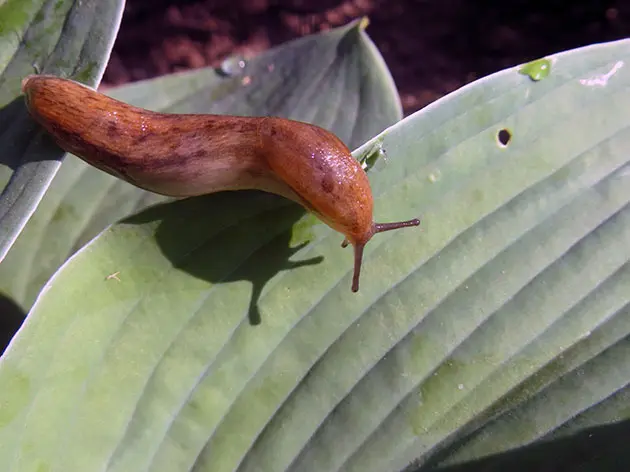
Slugs often infect low varieties and young plants.
To get rid of slugs, it is necessary to scatter Thunderstorm bait or Methylaldehyde under the bushes, and at night spread moistened sheets of plywood on a flower bed. The next day, the caught pests can be collected and destroyed.
Preventive measures
The fight against diseases and pests is not only about treatment. First of all, you need to follow the basic rules of prevention – they will help, in principle, to avoid most problems:
- The soil at the roots of the hosta should not be waterlogged. It is necessary to adhere to moderate watering, because in swampy conditions, fungal diseases spread especially quickly.
- Every year the host must be fed with complex mineral fertilizers. A balanced composition of the soil strengthens the plant’s endurance and reduces the risk of infection by viruses and fungi.
- In autumn, a plot with ornamental crops must be carefully cleaned. All plant debris is collected from the ground, taken out to the far corner of the garden and destroyed, since it is under the fallen leaves that larvae and fungal spores usually hibernate. For the same reason, it is recommended to prune the host for the winter, dangerous bacteria can develop under the plant’s own withered leaves.
- Hosta plantings should not be overly thickened. Plants growing nearby must receive enough light and fresh air, otherwise the risk of developing fungal diseases will greatly increase.

So that the host does not suffer from diseases, you need to monitor the cleanliness of the area
To save the host from fungal diseases and viruses, it is recommended to carry out annual preventive spraying. At the beginning of spring, the flower bed is treated with Bordeaux liquid or any fungicidal agent according to the instructions, then the treatment is repeated twice more with intervals of 15-20 days. If the roots have fungal spores in the soil, then with timely prevention they simply cannot develop and manifest themselves with characteristic symptoms.
With regard to pests, insecticide spraying is usually carried out after the presence of insects becomes apparent. For preventive purposes, it is recommended to regularly loosen the soil and replace its top layer annually, in which the larvae usually hide.
Conclusion
Hosta diseases in a neglected state can quickly destroy an ornamental plant. But if you notice the symptoms in time and start treatment, then most ailments can be dealt with.









